Urine-based testing for HPV
Although human papillomavirus testing with urine is slightly less sensitive than using cervical samples, it may be easier for women than going to a doctor’s office for a Pap smear.
©jarun011 - stock.adobe.com

Results of a study by UK investigators show that human papillomavirus (HPV) testing with urine samples is slightly less sensitive than using cervical samples. One of the upsides of the technology, however, is that it may be more acceptable and accessible to women than going to a doctor’s office for a Pap smear.
Published in BMJ Open, the findings are from a cross-sectional study in a secondary care colposcopy clinical in North West England. The patients were women aged 25 or older seen at the clinic for management of abnormal cervical screening results of a suspicious-looking cervix.
The researchers used Abbott RealTime(ART) to test samples from 79 women and Roche Cobas 4800 (RC) to test samples from 66 women for high-risk HPV (HR-HPV). Both self-collected urine and vaginal samples were assayed. Colposcopic opinion was recorded and directed cervical biopsies taken if clinically indicated. A questionnaire also was used to determine how acceptable the women found taking their own urine samples.
Preservative-fixed but undiluted urine had good concordance with vaginal samples for detection of HR-HPV. Urine was 83% sensitive for detecting cervical intraepithelial neoplasia (CIN) 2+ versus 89% sensitivity for cervical and vaginal samples tested with ART and 88% sensitivity for RC.
Of the 98 women who responded to the questionnaire, 39 said they preferred to provide a urine sample, 32 chose a vaginal sample, and 17 chose a cervical sample.
The authors noted that the disadvantage of use of urine for HPV testing is the inability, in the event of a positive result, to perform reflex testing. They said, however, that “data suggest that women who screen positive for HR-HPV are highly likely to attend for cervical cytology.”
The researchers posited that urine-based testing may cost less than standard screening because no doctor’s appointment or special equipment is necessary. They recommended future studies comparing the performance and acceptability of use of urine versus vaginal self-sampling in a general screening population.
